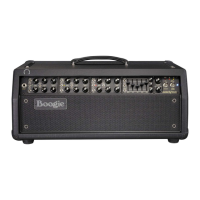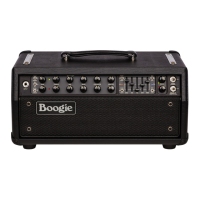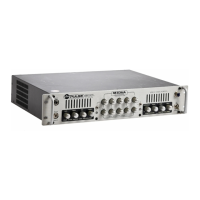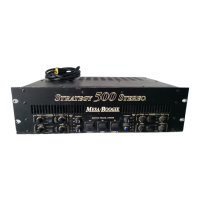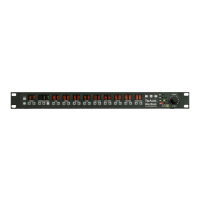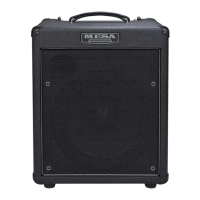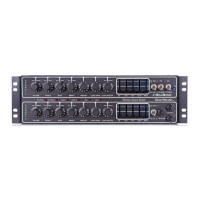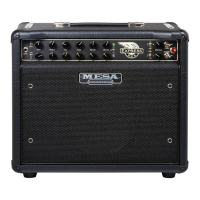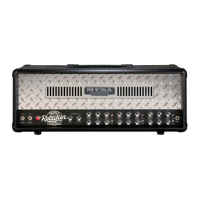PAGE 19
clipping there and ensure better performance when going Direct in both Live and Recording applications.
The most usable and well-behaved zone on the MASTER is found between 9:00 and 1:00. In this range there is
plenty of room for adjustment in either direction (up or down in volume) with most preamp settings and it also
provides a reasonable signal level for the CabClone’s Input stage.
Above 1:00 on the MASTER, with most preamp GAIN settings, you enter an area of diminishing returns in re-
gard to Tone. The low end starts to become looser and less controlled, and the tracking will get sloppy. Also,
at these higher output levels, a more pronounced midrange bump from the 6L6 power tubes emerges and can
become a dominant part of the sound. These two characteristics combined can work for some musical styles,
mostly those relying on lower preamp gain and some power overdrive, but either and possibly both could be
detrimental to great rock and Heavy sounds, where a scoop in the midrange and tight-tracking low end is for
most players a prerequisite.
Beyond that cautionary advice, use the MASTER as you see fit to balance your Channel’s Modes and global-
level requirements.
PRESENCE
The PRESENCE is a Tone control located in the later part of the signal chain in the power section. It adjusts
the mix of a predetermined (high) frequency relating to the negative feedback in the power section. It is a very
powerful control, and its setting can give the impression of opening the sound up and adding brightness and
attack, or clamping it down, compressing and darkening it. These characteristics, in turn, aect how you per-
ceive dynamic content, as brighter sounds appear as faster while warmer sounds feel slower and more relaxed.
This addition - or removal of - top end with the PRESENCE can seem to move the sound forward and back (near
or far) in the musical landscape (mix). It also has an impact on our perception in the time domain and helps
define whether the sound feels either “tight-tracking” and “fast” or “slow” and “behind the beat.”
Clean sounds handle higher PRESENCE settings well to a point, then things can become too forward in the
top end. Overdrive sounds usually call for lower to medium PRESENCE settings. Overly high settings of the
PRESENCE there can quickly lead to buzzy, unfocused top-end characteristics, especially with single-note
lead playing, which is rarely good. Some Crunch Rhythm and Heavy chording sounds can tolerate added cut
and sizzle from the medium to higher range of the PRESENCE, but how much usually depends on the Track
or ensemble mix it is sitting in.
As mentioned before, along with the PRESENCE, the top end can be swapped around by utilizing the diering
frequencies found in the TREBLE and even upper range of the MID control that carries a fair amount of high
mid/low treble region cut. Between these three regions and flavors of high frequencies, you will be able to
sculpt just the right type and amount of top end you need. And if you are still in need of more, or just dierent,
there’s plenty left in the upper two Sliders of the 5-Band Graphic EQ!
TREBLE
Next to the GAIN, the TREBLE is probably the most critical control in all Channels and their Modes. It feeds the
Tone control string, and therefore, its setting can determine how powerfully the MID and BASS work. Like the
GAIN, there are three zones in its range: low, middle, and high. These are as simple to understand as warm, cut,
and bright, with the bright zone having a nickname, which is “dangerous” in terms of musically balanced sounds.
The lowest part of the range is where the round, warm sounds will be found. The most usable part of this range
is between 9:00 and 11:00, with the portion below 9:00 having few uses apart from jazz sounds and 10:00 -
11:00 being the most useful.
The middle range is where most of the best performance and sounds are found for a wide range of instruments
and styles, 11:00 – 12:45 being by far the most frequented for most players. In this range, the balance between
all the Tone controls is at its best and plenty of brightness, cut, and openness is available for almost any style
and instrument.
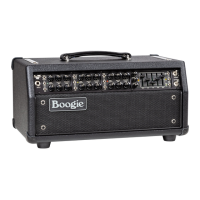
